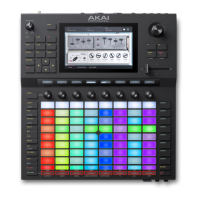66
Audition Outputs: This determines which pair of outputs will play any auditioned sounds. These sounds include:
samples, tracks, and projects in the Browser; sample playback, Cue Preview, and Slice Preview in Sample Edit
Mode; and sample playback in the Keep or Discard Sample window in the Sampler.
Cue Preview: This determines if/how audio is played as you move the cue playhead. As you move the cue playhead
through a sample waveform, you can set it to play the small part of the sample before the cue playhead (Before),
play the small part of the sample after the cue playhead (After), or not play at all (Off). You can also set this in
Sample Edit Mode (see Modes > Sample Edit Mode > Settings).
Slice Preview: This determines if/how audio is played as you move a slice marker. As you move the slice marker
through a sample waveform, you can set it to play the small part of the sample before the slice marker (Before), play
the small part of the sample after the slice marker (After), or not play at all (Off). You can also set this in Sample Edit
Mode (see Modes > Sample Edit Mode > Settings).
Audio Warp Algorithm: This determines how a sample is “warped” when you adjust the length of a sample without
changing its pitch (e.g., the Warp function in Audio Region Edit Mode for audio tracks or in Track Edit Mode for clip
tracks).
Note: The Warp algorithms are very CPU-intensive and can result in audio drop-outs during playback if used too
freely. Be mindful of how (and how often) you use the warp function. You can reduce the CPU resources required by
using the Basic warp algorithm, which is less CPU-intensive.
Audio Track Auto Warp: This determines how recorded audio track regions are warped. When set to On, any audio
track region that you record will be warped automatically to match the current project tempo. You can then adjust
the project tempo while the audio track region remains in time.
Note: When you record an audio file, the current project tempo will be embedded with it. This information is stored
within the sample file when you save the project. When you warp an audio track region, the warping algorithm uses
this project tempo and the current value in the BPM field to generate the “stretch factor.”
BPM Auto Detection: This enables automatic detection of BPM from loaded samples.
BPM Detection Range: This defines the range of detectable BPM values when you use any automatic BPM
detection function in the software or when you press the Tap button to enter a new tempo.
Sync
Tap the Sync field (in the center of the top of the screen) and then turn the data dial or use the –/+
buttons to set whether your Force hardware receives MIDI Clock information (MIDI Clock), MIDI Time
Code information (MTC), communication from Ableton Link, or none of these (Off). Alternatively,
double-tap Sync and tap the desired option to select it.
This is the same setting as the Receive menu in Sync tab of your Preferences. See Preferences >
Sync for more information.
Note: Ableton Link is a new technology that synchronizes beat, phase and tempo of Ableton Live
and Ableton Link-enabled applications over a wireless or wired network. See Preferences > Wi-Fi or
Preferences > Hardware > Ethernet to learn how to connect to a network.
Mode
Tap this icon to switch Force to Computer Mode. In the screen that appears, select whether you want to
continue to Computer Mode or Cancel and return to your current mode and project. It is recommended
to save your project before switching to Computer Mode since you cannot freely switch between
Standalone and Computer Modes without also closing your current project.
See Standalone vs. Computer Mode to learn more.

